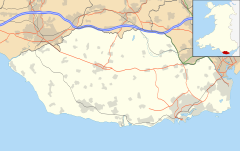Wick, Vale of Glamorgan
Wick
|
|
|---|---|
| Wick shown within the Vale of Glamorgan | |
| Population | 732 (2011) |
| OS grid reference | SS923721 |
| Principal area | |
| Ceremonial county | |
| Country | Wales |
| Sovereign state | United Kingdom |
| Post town | COWBRIDGE |
| Postcode district | CF71 |
| Dialling code | 01656 |
| Police | South Wales |
| Fire | South Wales |
| Ambulance | Welsh |
| EU Parliament | Wales |
| UK Parliament | |
| Welsh Assembly | |
Wick (Welsh: Y Wig) is a small village in the Vale of Glamorgan in Wales, situated about 1.5 miles (2.4 km) from the coast. The closest towns are Llantwit Major, Cowbridge and Bridgend.
The village has two pubs, a village shop and a primary school. There are several footpaths and bridleways linking Wick with the surrounding countryside and the village is popular with cyclists. Walks from Wick include those to the local beaches, Traeth Bach and Traeth Mawr, via the Cwm Nash footpath at Monknash or from Dunraven Bay at Southerndown. The cliffs here form part of the Glamorgan Heritage Coast.
Archaeological evidence (such as the earthworks associated with burial mounds, settlements and enclosures) suggests that there was settlement in Wick from around 1600BC when a small proto-Celtic community may have developed, probably farming the surrounding land on a subsistence basis. The site of an ancient beacon tower lies just north-west of the village and to the south-west, on the cliff edge at Whitmore Stairs, is the earthworks of an Iron Age univallate hillfort, part of an ancient monument known as the Cwm Bach Camps. It is thought probable that the larger of the forts that make up this monument, situated approximately 1.5 miles (2.4 km) away on the Trwyn y Witch (Witches Point) headland, was at one time occupied by Caratacus (who led the Silures in resistance to the Roman occupation). Given its proximity to Tusker Rock, a small island named after Tuska (a Danish Viking), it is likely that Wick was a focus for Viking attacks on the south Wales coast. Local folklore suggests that beacons were lit on high ground around the village to warn of such raids and that attacks were fiercely resisted. It is thought that the village eventually came under Norman control in around 1097AD. Scheduled ancient monuments in Wick include Buarth Mawr Barn and Rhyle round barrow. Various archaeological finds have been made in Wick, including the discovery of a hoard of five Late Bronze Age socketed axes by Mr. Adrian Jones in 2005.
...
Wikipedia

